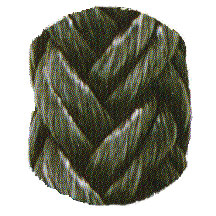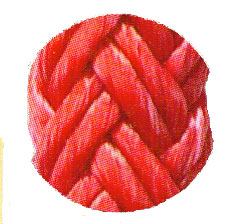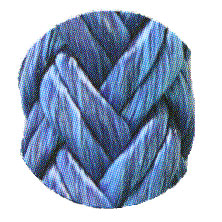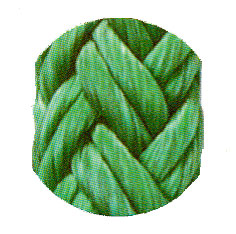12 Strand Braided Polyester
 A braided 12-strand, single-end-per-carrier polyester. This product is made from a variety of polyester fibers sourced from all over the globe, and is treated with a spliceable urethane coating, which is applied after the rope is braided. This coating firms the rope, increases snag resistance, improves abrasion resistance, and helps keep contaminants from entering the rope. Polyester 12-braid is easy to splice and repair if damaged in service. Available in several brilliant colors for rapid line identification and to track time in service, polyester 12-braid comes in unlimited lengths.
A braided 12-strand, single-end-per-carrier polyester. This product is made from a variety of polyester fibers sourced from all over the globe, and is treated with a spliceable urethane coating, which is applied after the rope is braided. This coating firms the rope, increases snag resistance, improves abrasion resistance, and helps keep contaminants from entering the rope. Polyester 12-braid is easy to splice and repair if damaged in service. Available in several brilliant colors for rapid line identification and to track time in service, polyester 12-braid comes in unlimited lengths.
FEATURES
- Specific Gravity of 1.38
- Single end per carrier
- Snag and abrasion resistant
- Contaminant resistant
- Fully spliceable
Sold in 600' rolls; Standard color is orange, call for availability of other colors.
| Dia. Inch | Average Break Strength Lbs. | Minimum Break Strength Lbs. | Maximum Working Load 5:1 | Weight Lbs. Per 600' |
|---|---|---|---|---|
| 5/16" | 3,600 | 3,060 | 720 | 17.4 |
| 3/8" | 5,400 | 4,590 | 1,080 | 23.4 |
| 7/16" | 8,100 | 6,885 | 1,620 | 35.4 |
| 1/2" | 11,250 | 9,562 | 2,250 | 51.0 |
| 9/16" | 14,850 | 12,622 | 2,970 | 57.0 |
| 5/8" | 16,380 | 13,923 | 3,276 | 63.0 |
| 3/4" | 21,600 | 18,360 | 4,320 | 70.8 |
| 7/8" | 31,950 | 27,158 | 6,390 | 94.8 |
| 1" | 38,700 | 32,895 | 7,740 | 171.0 |
 A braided 12-strand rope constructed of Performance Fiber's type 1W81 high tenacity polyester. This product is treated with a spliceable urethane coating, which is applied after the rope is braided. This coating firms the rope, increases snag resistance, improves abrasion resistance, and helps keep contaminants from entering the rope. Polyester 12-braid is easy to splice and repair if damaged in service. The two-end-per-carrier construction creates a larger void in the middle of the rope, making used rope splicing easier, or production splicing for sling making faster.
A braided 12-strand rope constructed of Performance Fiber's type 1W81 high tenacity polyester. This product is treated with a spliceable urethane coating, which is applied after the rope is braided. This coating firms the rope, increases snag resistance, improves abrasion resistance, and helps keep contaminants from entering the rope. Polyester 12-braid is easy to splice and repair if damaged in service. The two-end-per-carrier construction creates a larger void in the middle of the rope, making used rope splicing easier, or production splicing for sling making faster.
Sold in 600' rolls; Standard color is orange, call for availability of other colors.
FEATURES
- Constructed of Performance Fiber's Type 1W81
- Two end per carrier
- Snag and abrasion resistant
- Contaminant resistant
- Fully spliceable
| Dia. Inch | Average Break Strength Lbs. | Minimum Break Strength Lbs. | Maximum Working Load 5:1 | Weight Lbs. Per 600' |
|---|---|---|---|---|
| 1/4" | 2,500 | 2,250 | 500 | 13.2 |
| 5/16" | 4,000 | 3,600 | 800 | 16.8 |
| 3/8" | 6,000 | 5,400 | 1,200 | 24.0 |
| 7/16" | 9,000 | 8,100 | 1,800 | 42.6 |
| 1/2" | 12,500 | 11,250 | 2,200 | 54.0 |
| 9/16" | 16,500 | 14,850 | 3,300 | 67.2 |
| 5/8" | 18,200 | 16,380 | 3,640 | 76.2 |
| 3/4" | 24,000 | 21,600 | 4,800 | 102.0 |
| 7/8" | 35,500 | 31,950 | 7,100 | 153.6 |
| 1" | 43,000 | 38,700 | 8,600 | 193.8 |
| 1-1/8" | 56,000 | 50,400 | 11,200 | 209.4 |
| 1-1/4" | 65,500 | 58,950 | 13,100 | 235.8 |
| 1-5/16" | 74,750 | 67,275 | 14,950 | 279.6 |
| 1-1/2" | 93,500 | 84,150 | 18,700 | 340.8 |
| 1-5/8" | 112,500 | 101,250 | 22,500 | 432.6 |





